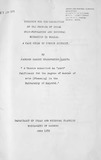Strategy for the resolution of the problem of rural, over-population and internal migration in Uganda: a case study of Bugisu district

View/
Date
1976Author
Kalifa, Jackson Herbert M
Type
ThesisLanguage
enMetadata
Show full item recordAbstract
The problem of rural over-population and internal
migration was realized by the Government of Uganda
as early as 1959. Rural over-population, since then,
has been found to obtain in the districts of Kigezi,
Bugisu, West Nile and Bukedi. Internal migrants have
also been known for a long time, to originate from
the above mentioned areas. The causes of this problem
have been)among others, mainly due to land shortage
and lack of employment opportunities in)these areas
enough to absorb the extra rural populations.
This study thus sets out to look further into the
problem of rural over-population and internal migration
in Uganda and proposes strategies that will have to be
used to resolve the whole problem Means to
implement such strategies are also proposed.
The study has taken case study of Bugisu
district on the Western slopes of Mount Masaba (Mt.
Elgon). A more detailed study has been carried out
in Manjiya country in the same district and a physical
development plan laid out.
that.This study has found out the above problem and
its main causes does exist and that the list of the
above mentioned areas has~ increased to include Teso
and shortly Mengo In these areas, the projected
population exceeds the "capacity" population based on
the concept of "land carrying capacity" of the areas
( XIV)
concerned~ In other words, the working population
excessive with reference to the current techniques of
cultivation in these areas. Consequently, the response
a£ the inhabitants there, has been to voluntarily out migrate to other parts of the country especially the
adjoining areas - Ankole, Bunyoro, Busoga and Kyaggwe
and Bugerere. Most of this immigration has been directed
to rural, areas rather than urban areas: Unwillingness
to out migrate has been very characteristic of the
Bagisu.
Furthermore, it has been found out that the
district$ of Bugisu is mainly dependent on and agricultural
economy geared primarily to the production of subsisted food crops such as bananas, cassava, finger
millet,. maize and sweet potatoes, and cash crops
mainly Arabic coffee on the highlands and cotton on
the lowlands.
Also,the urban economy is in a low state of
evolution' and therefore does not provide sufficient
employment opportunities to siphon off the extra rural
population from agricultural land. This has been
worsened by the low standard o£ both physical and social
infrastructural development in both urban and rural
sectors which has consequently discouraged the development of alternative employment opportunities such as
could be found in small-sale industries.
The main strategy proposed in this study to
( XV)
resolve the problem of rural over-population and
internal migration in Manjiya is that of Rural
transformation: Program which will involve a land
re"form programme, an agricultural development programme and the establishment of "growth centers" (poles) to
act as centers of innovation development and diffusion.
In addition, a social welfare development programme
involving educating the rural people and instituting
a population policy which will recognize the official.
existence of the family Planning Association of
Uganda, and deploy its expertise towards reducing
rural population growth rates. After all, in the final
analysis, everything towards solving the problem of
rural over-population, depends on the extent to which
population growth rates can be controlled
Citation
Master of arts in PlanningPublisher
University of Nairobi Department of Urban and Regional Planning
